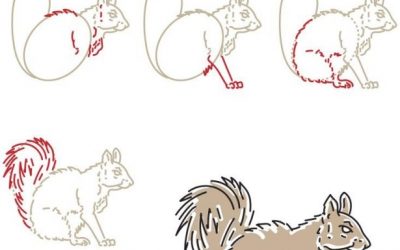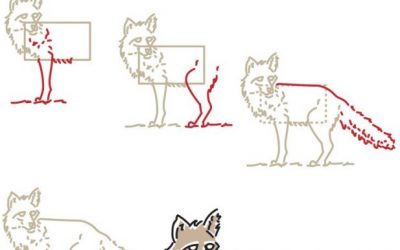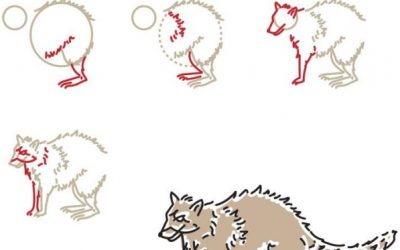
MATERIALS
• Art Spectrum Colourfix Paper Beige 100 x 70cm
• Four values of Art Spectrum Flinders Blue Violet ranging from the darkest to the lightest
• Art Spectrum Jacaranda two values
• Two values of Art Spectrum Flinders Red Violet
• Art Spectrum Warm Grey
• Art Spectrum Aust. Leaf green, Grey green, Greenish Umber, Pthalo Green/blue
• Art Spectrum Pilbara Red three values
• Senneliers in lightest yellow, brick and turquoise
• Eraser
• 1 or 2 inch paint brush
STEP ONE
These sun bleached trees with their twisted shapes are irresistible to me, whilst some people find them spooky, if you look at them from a different point of view you will see the elegant shapes and gestures in their bare branches. I began this piece with a very basic charcoal sketch directly onto the paper. As I already had a clear idea of where I hoped this painting would end up, it was really just to get the size of different elements in relation to each other and give some idea of whether the composition/concept was sound. In this particular piece I am only using the reference photo as an idea, ie the dead tree, the slight rise in the foreground, the background hills etc.

STEP TWO
Next I lightly brush off the charcoal with a soft brush. If you do this carefully, it will leave a faint outline of your initial sketch. The sky was painted with peach, pale blue, pale pink and yellow, lightly layered and even more lightly blended. When blending I try to let the pastel sticks do the work rather than use my fingers as I find this keeps the colours clean and avoids muddiness from mixing the pastel particles into each other. Then I block in the hills and sky with a couple of different values each of green, violet and peach, keeping the deeper shades for the closer hills.

STEP THREE
Once I am happy with the first layer on the hills, I add some middle ground. At this point I am still feeling my way with colours, if they are obviously wrong I brush them off and try again (sometimes this can produce some happy accidents). At this point it can sometimes look a bit of a mess but I try to keep in mind a clear idea of where I want to end up. I am usually able to tell whether it is working or not by stepping back often and just analysing the colours and temperatures to make sure that the perspective is still working and the colours are harmonious and pleasing together. In this particular case I have used some of my reds and warmer violets, as well as greenish umber.

STEP FOUR
Normally I work from top to bottom, left to right so I don’t dirty finished parts of the piece with falling pastel dust and I don’t smudge anything with my hand. At this stage I have established the foreground base colours I want to use and suggested some trees along the bottom of the hills – these were an afterthought as it looked a bit empty… I also brushed off a bit of the colour in the mid ground as it looked a little too red. Don’t be afraid to change parts of your composition if you find it lacks impact or is distracting from your focal point. I try to match my strokes to the direction of the land so the topography reads better. At this point in the piece it is hard to describe my colour choices as I am just trying to follow my instincts to describe the way that I see this landscape. Sometimes when I get to this point in a painting I start to doubt myself and it can be tempting to try to tone things down but then I remind myself that there is still a long way to go and besides, I like lots of colour.

STEP FIVE
Okay, back to the top of the picture and working my way down, this is where it starts to get fun. I avoid the foreground at this stage as I still haven’t resolved it in my head yet. This is when I really add some colour and some form to the hills and trees and the focal point. I add some blues and greys to the shadows on the dead tree and very lightly scuff some raw umber in it lightest value over the sunlit side. Then I soften the farthest hills by dragging some sky colour down over them. I try to be adventurous in the middle ground and add unexpected colours like turquoise blue, orange and violet to the shadows; they can always be erased if they look strange. When I paint foliage I like to use some warm colours such as Burnt Sienna or Pilbara Red under the greens. If you use a light touch you will still see these colours peeking through, also I like to use warmer greens, tending towards yellow, for foliage when you want to capture afternoon or evening light. You might also notice the dead tree changing shape; it evolves all the way through this piece mostly due to outside input!

STEP SIX
I start adding the grasses to the foreground, using the side of the pastel, I tap it onto the paper in random directions. I try to add some vibration to the grass by using orange over violet, yellow over blue, violet over orange etc. It is also important to keep in mind where the shadows are and use cooler, darker values in and around them. Using my softest pastels I add little dots for highlights above the grass to describe where the sun is hitting the hill. This is also when I add a few more colours into the shadows on the tree and some peach to the sunlit side where the yellow light of afternoon/ evening is catching it. I change the shape of the tree for the last time.

FINAL STEP
I step back a few metres and look at the piece from every angle. At this point, I decided to make a few of the grasses a bit longer as they seemed a bit uniform. I tidy up any little smudges and rough edges, sign and burnish. Burnishing means laying some glassine paper over the finished piece and rubbing your fis firmly over the painting from top to bottom. Do this on a firm, flat surface (I use our pool table!). I do this instead of using fixative to push any loose pastel into the tooth of the paper. I avoid using fixative as I think it dulls the sparkle that makes pastel special.

ARTIST’S HINTS AND TIPS
• Keep a thick piece of folded rag nearby so you can continually wipe your pastels and your hands clean to stop colours contaminating each other.
• Take your own photos to avoid any copyright issues.
• An ordinary lead pencil eraser works very well for taking off small mistakes.
• Don’t be scared to experiment, try all the different surfaces and pastel brands that you can, you don’t need to use large amounts and many papers can be washed off.
• Don’t sacrifice a good piece by leaving in an element that you know doesn’t work but took you lots of effort to add.
• Finding the right value and the right temperature is more important than finding the right colour.
• Try using watercolour, thinned oil paint or pastel wet with water and brush as an underpainting to get you started as it can help overcome that empty blank page and remind you of your original idea.
• Step back from your painting regularly so you don’t get bogged down in meaningless details and lose the “big picture”.
• View your finished work through a mirror and upside down. Let it sit out of sight for a day then put it somewhere you will see it by accident, this helps you spot any composition or colour problems.
• Stop work when you think you are ALMOST finished because you probably are.
• Ask for other peoples’ opinions and don’t sulk if you don’t like it (and if you can do this you’re a better person than me!)
• Check out as much work by other artists as you can and try their techniques, but if they don’t work for you don’t worry, there are no hard and fast rules. Don’t rush to adopt any particular style, just find subject matter that inspires you and your own style will find you.





